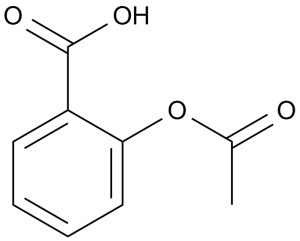This product is for research use only, not for human use. We do not sell to patients.

| Size | Price | Stock |
|---|---|---|
| 100g | $300 | Check With Us |
| 200g | $400 | Check With Us |
| 500g | $625 | Check With Us |
Cat #: V1062 CAS #: 50-78-2 Purity ≥ 98%
Description: Aspirin (Acetylsalicylic acid; ASA; Acetylin; Claradin), a widely used analgesic and a salicylate analog, is a non-selective and covalent/irreversible inhibitor of COX1 and COX2 enzymes with a broad range of biological activities such as anti-inflammatory and pain relieving effects.
Publications Citing InvivoChem Products
Product Promise

- Physicochemical and Storage Information
- Protocol
- Related Biological Data
- Stock Solution Preparation
- Quality Control Documentation
| Molecular Weight (MW) | 180.16 |
|---|---|
| Molecular Formula | C9H8O4 |
| CAS No. | 50-78-2 |
| Storage | -20℃ for 3 years in powder formrr |
| -80℃ for 2 years in solvent | |
| Solubility In Vitro | DMSO: 36 mg/mL (199.8 mM)rr |
| Water: <1 mg/mLrr | |
| Ethanol: 36 mg/mL (199.8 mM) | |
| Solubility In Vivo | 4% DMSO+PBS: 10mg/mL |
| SMILES Code | OC[C@@H]1[C@@H](O)[C@@H](O)[C@H](N2C3=NC(F)=NC(N)=C3N=C2)O1 |
| Synonyms | Acetylsalicylic acid; Acetylin; Claradin |
| Protocol | In Vivo | Aspirin (5-150 mg/kg, PO, once) shows significant antipyretic activity in adult yeast-fevered male rats |
|---|---|---|
| Animal model | Male albino Charles River rats (200-250 g, 8 animals/group, fever was induced by 20 ml/kg of a 20 % aqueous suspension of brewer’s yeast which was injected SC in the back below the nape of the neck) | |
| Dosages | 5, 25, 50, 100 and 150 mg/kg |
| Solvent volume to be added | Mass (the weight of a compound) | |||
|---|---|---|---|---|
| Mother liquor concentration | 1mg | 5mg | 10mg | 20mg |
| 1mM | 5.5506 mL | 27.7531 mL | 55.5062 mL | 111.0124 mL |
| 5mM | 1.1101 mL | 5.5506 mL | 11.1012 mL | 22.2025 mL |
| 10mM | 0.5551 mL | 2.7753 mL | 5.5506 mL | 11.1012 mL |
| 20mM | 0.2775 mL | 1.3877 mL | 2.7753 mL | 5.5506 mL |
This equation is commonly abbreviated as: C1 V1 = C2 V2
- (1) Please be sure that the solution is clear before the addition of next solvent. Dissolution methods like vortex, ultrasound or warming and heat may be used to aid dissolving.
- (2) Be sure to add the solvent(s) in order.




































